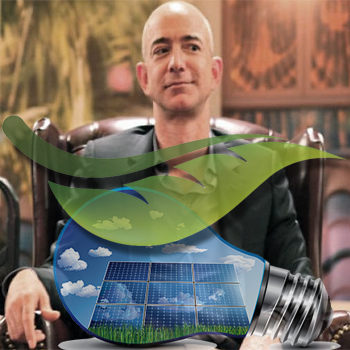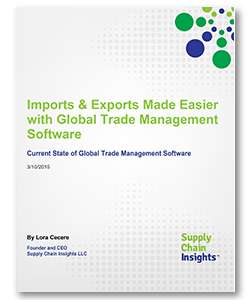Amazon and 100-Percent Renewable Energy: Will It Really Happen?

Amazon, led by CEO Jeff Bezos, is the latest tech giant to publicly commit to powering its cloud computing division with 100 percent renewable energy.
With one quiet web update this week, Amazon becomes the latest tech giant with a less-than-stellar sustainability track record to hail a major potential shift in strategy.
Just a few months after the company hired its first corporate sustainability chief, Amazon cloud computing division Amazon Web Services has declared “a long-term commitment to achieve 100-percent renewable energy usage for our global infrastructure footprint.”
An Amazon spokesperson declined to elaborate on when and how the company might go about building out a clean energy portfolio, referring all questions about the company’s sustainability strategy to a corporate web page.
No information currently available addresses whether Amazon might be considering similar initiatives for its primary e-commerce business, which includes large warehouses and expansive transportation networks.
Still, shifting Amazon Web Services’ massive network of data centers serving corporate clients like Airbnb and Unilever to renewable energy would in and of itself be a noteworthy change.
The catch, as groups including Greenpeace have already pointed out: It’s anyone’s guess when and how Amazon might actually go about following through on the energy commitment.
Much like the hire back in August of the company’s first sustainability officer, industry veteran Kara Hurst, Amazon made no initial formal announcement about the new renewable energy commitment. Instead, the Amazon Web Services web page was updated sometime in the past week (likely in the last day or so) to include the line about a long-term effort to transition to 100 percent renewables.
“Apple, Facebook and Google, three of Amazon’s peers and rivals, all have laid out road maps that explain how they intend to achieve their goals of procuring 100 percent renewable energy,” wrote David Pomerantz, who oversees energy advocacy and communication for Greenpeace, in a blog post on Wednesday. “Amazon has not offered that kind of road map yet, and it has some work to do to catch up.”
Indeed, Amazon was called out in a Greenpeace report earlier this year on efforts to curb emission from data centers - an industry that Stanford University notes consumes about 1.5 percent of global electricity - when it got three failing grades and one “D” for its clean energy efforts (or lack thereof).
That’s in contrast to fellow big-name tech companies like Apple Inc., which is now the biggest private owner of solar facilities in the country. Google’s “Google Green” initiative publicly lists clean energy investments the company has made that total hundreds of millions of dollars.
Other relative newcomers to Silicon Valley’s cloud computing craze, like SalesForce and Box, have also made 100 percent renewable energy pledges.
When it comes to Amazon making good on its new energy commitment, Greenpeace suggests: greater transparency when it comes to Amazon’s existing energy and greenhouse gas footprint; a focus on coal-powered data centers in Virginia and a concrete list of “guiding principles” outlining how the company defines renewable energy.
“The thing they can do right now is release their footprint data,” Pomerantz said. “All their competitors do that.”
Beyond Data Centers
The varying clean energy approaches of large technology firms underscore global efforts across business sectors to reevaluate the viability of switching to renewable sources.
As prices for solar, wind and other renewables continue to fall, large companies in industries like retail - such as IKEA - are experimenting with new power sources, such as rooftop solar. Projected ongoing increases in the price of fossil fuels add additional economic incentive to the mix.
Data centers are a natural place for technology firms to start attempting to inject more sustainable elements into their business models, Pomerantz said.
While much work remains to be done to ensure that lofty 100-percent renewable energy goals are actually met, companies like Amazon with a complex supply chain perfectly illustrate other gaping opportunities for improvement.
“The next big step once these tech companies seize the opportunity on data centers would be working back through their manufacturing supply chains,” Pomerantz said.
Apple, in another example of increasing clean energy commitments under current CEO Tim Cook, has already floated the potential to cut down on carbon emissions linked to the production of its hardware products.
While Google, Facebook, Box and Salesforce are all predominately software companies, Amazon’s e-commerce operation and perponderance of logistics needs make it a prime suspect for future sustainability advocacy efforts (not to mention advocacy around labor issues or other contentious facets of its goods delivery business).
For now, all eyes are on household names in the tech sector to follow through on early efforts to make the offline components of their online businesses more sustainable.
Source: GreenBiz
Related: Apple Focusing on Greening Its Supply Chain

Article Topics
Supply Chain Insights News & Resources
Talking Supply Chain Podcast: Insights on Leaders - The Top 25 CHAPTER 3: Bricks Matter Infor Aquires GT Nexus - If I Had a Magic Wand! Why Are We Letting Digital Marketers Define The Future World View of The Supply Chain? Imports & Exports Made Easier with Global Trade Management Software Maximizing the ROI in Supply Chain Planning Getting Inventory Right: Hope with Hype and Recycled Supply Chain Software? More Supply Chain InsightsLatest in Supply Chain
Amazon Logistics’ Growth Shakes Up Shipping Industry in 2023 Spotlight Startup: Cart.com Walmart and Swisslog Expand Partnership with New Texas Facility Nissan Channels Tesla With Its Latest Manufacturing Process Taking Stock of Today’s Robotics Market and What the Future Holds U.S. Manufacturing Gains Momentum After Another Strong Month Biden Gives Samsung $6.4 Billion For Texas Semiconductor Plants More Supply Chain













